-
Paper Information
- Paper Submission
-
Journal Information
- About This Journal
- Editorial Board
- Current Issue
- Archive
- Author Guidelines
- Contact Us
Geosciences
p-ISSN: 2163-1697 e-ISSN: 2163-1719
2018; 8(1): 14-20
doi:10.5923/j.geo.20180801.03

Geochemistry and Petrology of Guguruji Amphibolites from Egbe-Isanlu Schist Belt, Southwestern Nigeria
Olusola Amos OlaOlorun1, Akindele Ojo Oyinloye1, Adeola Rita Adeleye2
1Department of Geology, Ekiti State University, Ado-Ekiti, Nigeria
2Department of Geology, Afebabalola University, Ado Ekiti, Nigeria
Correspondence to: Olusola Amos OlaOlorun, Department of Geology, Ekiti State University, Ado-Ekiti, Nigeria.
| Email: |  |
Copyright © 2018 The Author(s). Published by Scientific & Academic Publishing.
This work is licensed under the Creative Commons Attribution International License (CC BY).
http://creativecommons.org/licenses/by/4.0/

Geochemistry and petrology of Guguruji amphibolites from Egbe-Isanlu Schist belt, Southwestern Nigeria has been carried out to determine its nature and geochemical characteristics. The petrographic study of some of the samples reveals that mineral composition is uniform in some exposures and varied more in others. The thin sections reveal essentially biotite, hornblende, plagioclase, quartz, actinolite, tremolite, and opaque minerals. The minerals have random orientation of long axes of abundant hornblende and subordinate plagioclase crystals. The amphibolites are characterized by average contents of SiO2 (≤54%), Al2O3 (<15%), MgO (<10%), CaO (13.7%) and generally low total alkali (<2%), P2O5 (0.3%), MnO (<0.3%) and TiO2 (<2%) values. Other chemical parameters such as CaO / Al2O3 (<0.9) and Rb/Sr (<0.13) confirms its ortho-genetic origin. Binary plot of Na2O + K2O versus SiO2 and ternary diagram of Fe2O3– Na2O –MgO suggests that the amphibolites are of a precursor magma of subalkaline/basaltic and tholeiitic petrogenetic affinity. The trace element characterization of the amphibolites implicates within-plate tectonic setting.
Keywords: Guguruji, Amphibolites, Tholeiitic, Petrogenetic affinity
Cite this paper: Olusola Amos OlaOlorun, Akindele Ojo Oyinloye, Adeola Rita Adeleye, Geochemistry and Petrology of Guguruji Amphibolites from Egbe-Isanlu Schist Belt, Southwestern Nigeria, Geosciences, Vol. 8 No. 1, 2018, pp. 14-20. doi: 10.5923/j.geo.20180801.03.
Article Outline
1. Introduction
- The Nigerian Basement Complex is dominated by Precambrian gneisses and migmatites with intercalations of quartzites and schists which bears strong imprints of the Pan-African thermotectonic deformations. Nigeria lies in the Pan- African mobile belt of West Africa where rocks are reported to have undergone polycyclic metamorphism and deformation. In Southwestern Nigeria (from where this research emanates), the main lithologies include the migmatite, gneisses, amphibolites, granites and pegmatites. Other important rock units are the schists, made up of biotite schist, quartzite schist, talc-tremolite schist, and the muscovite schist [1]. The crystalline rocks intruded these schistose rocks. The schists as described by [2] has low-medium grade metasedimentary rocks occurring in a nearly North-South trending form and are in-folded into the gneissic-migmatite complex on the western half of Nigeria (Fig.1). The schist belts are dominated by pelitic to semi-pelitic and quartzitic schists interlayered with subordinate mafic-ultramafic rocks, marble and calc-silicate gneissic rocks [3]. The age of these rocks have been reported as Archean to early Proterozoic [3, 4]. Egbe-Isanlu schist belt is one of the schist belts in Southwestern Nigeria and lies northeast of the well-studied Ife-Ilesha and north of Igarra schist belts.
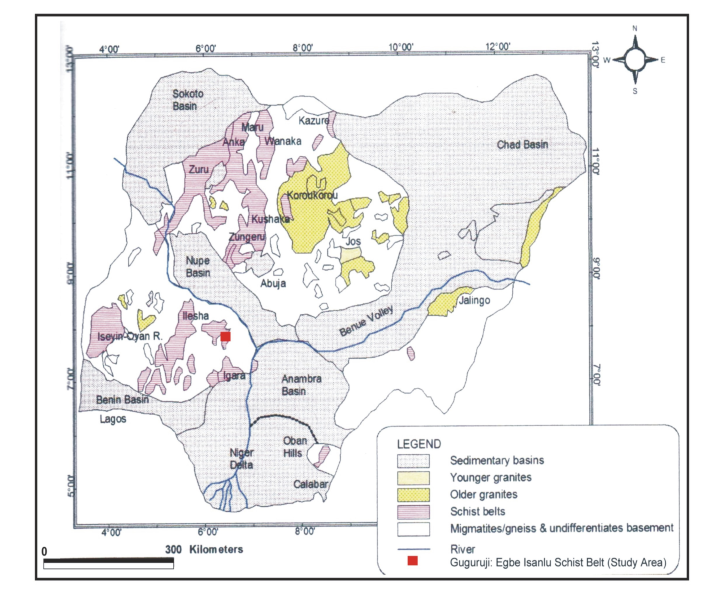 | Figure 1. General Geological Map of Nigeria showing the study area |
2. Geological Setting
- Guguruji amphibolites outcrop prominently around the central portion of the study area (Fig. 2) as large unmigmatized bodies. The rock is bounded by quartz-mica schist in the north, gneiss in the lower eastern flank and granite to the west. The rocks which occur generally as low-lying are of varying sizes, and are intruded in places by flat lying pegmatites. Many of the pegmatites had been worked for gemstones. The amphibolites are dense, heavy and fine - medium grained in texture with no obvious folds or foliations. The petrographic study of some of the samples reveals that mineral composition is uniform in some exposures and varied more in others. The thin sections reveal essentially biotite, hornblende, plagioclase, quartz, actinolite, tremolite, and opaque minerals. The minerals have random orientation of long axes of abundant hornblende and subordinate plagioclase crystals. The elongated crystals of hornblende in thin sections appear dark brown and greenish in some slides, the plagioclase are also lath like and in chaotic arrangement with the quartz crystals filling the spaces within these minerals. Garnet, biotite, sphene and opaque minerals constitute the accessory minerals.
 | Figure 2. Geology of Guguruji and environ 2 showing rock types and the drainage system |
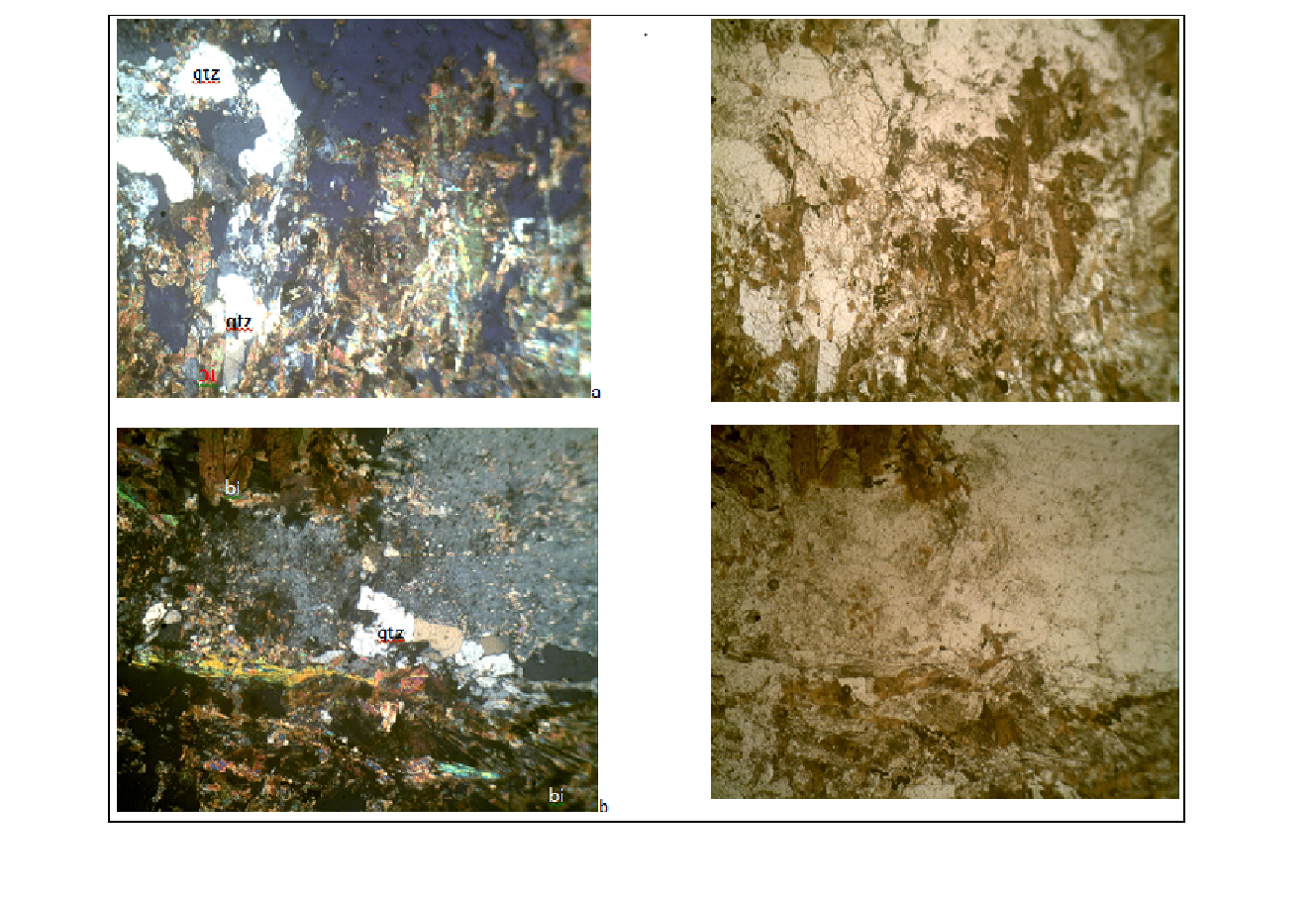 | Plates (a) and (b). Photomicrograph of Guguruji Amphibolites showing crossed and plane polarized formats (bi-Biotite, qtz-Quartz, hb-hornblende) |
3. Materials and Methods
- Fieldwork for this work was carried out between 2012 and April, 2013; during which several of the rocks were sampled each weighing about 2kg but twelve representative samples were set aside for study in this research. Major and trace element concentrations of the rock samples were determined at the Activation Laboratories in Ontario, Canada using Fusion ICP and ICP/MS analytical methods, the detail of which is available in [22]. This laboratory maintains regular routine exercise to ensure accuracy.
4. Data Presentation and Discussions
4.1. Major Elements
- The comprehensive details of the major oxides (%) and trace elements concentrations of the rock samples are presented in Table 1. The petrochemical affinity of the Guguruji amphibolites reflects the followings: the average SiO2 composition is 51% (48.43-54.04%), and comparable to Ilesha melanocratic amphibolite [17] and Ibadan amphibolite [18], Zungeru [21], and Lema-Ndeji amphibolites [23]. The Al2O3 mean value is 14.9% (14 - 17%), this is comparable to Wonu-Apomu [16], Ilesha and Obudu [24] varieties. Total iron (Fe2O3) content average is 11% with values ranging from 8 to 13%, this is lower than those of Zungeru, Obudu, and Wonu-Apomu, higher than those of Lema and Sepeteri types, but comparable to Ilesha amphibolites. Calcium oxide has a mean of 11.73% (6.43-13.74%) and it is comparable to those from Isanlu, Ilesha, Lema, Obudu and that of Ibadan but higher than those of Wonu-Apomu, Zungeru and Sepeteri varieties. The high iron content of Guguruji amphibolites is possibly due to possible low abundance of titanomagnetite while the high concentration of CaO indicates the preponderance of Ca – rich pyroxene [1] in the rock. MgO average concentration is 7% (3 – 10%) and compares well with Ibadan schistose variety but lower than those of other referenced. Na2O values for Guguruji amphibolites (av. 1.6%) and consistently higher than K2O (av.0.87%) reflect abundance of sodium rich feldspar in the rock. This is consistent with the petrological examination of the rock in which long disoriented large crystals of plagioclase were observed. Total alkali concentration of the rock is 2.2%; this is lower, but relatively comparable to Ibadan amphibolite (3.3%) and almost six-times that of Sepeteri (0.38%) and four-times that of Zungeru (0.51%) (Table 2). The alkali (K2O / Na2O) ratio varies from 0.14 - 0.94 with a mean of 0.57 which is greater than twice that of Ibadan (0.23) and about thrice of Ilesha (0.2) amphibolite varieties. These ratios reflect the sub-alkaline nature of the rocks under investigation.
 | Table 1. Major and trace element concentrations of Guguruji Amphibolites |
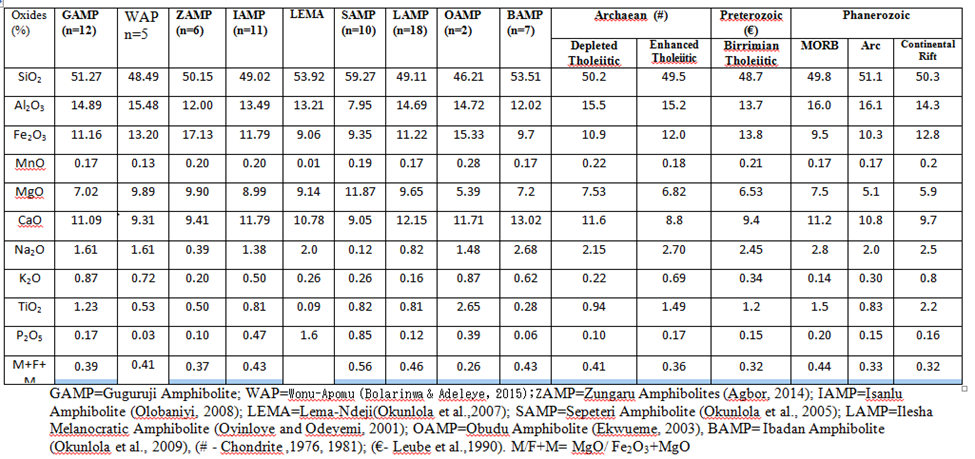 | Table 2. Major Elements Geochemistry of Guguruji Compared with Other Published Works |
4.2. Trace Elements Geochemistry
- The trace elements data of the representative samples of the Guguruji Amphibolites is presented along with the major elements in Table 1. The trace elements data reveal that, of the alkali earth elements, only Be, Sr, and Ba were detected while others were either absent or below detection limit. Barium (Ba) and Sr have mean concentrations of 228ppm and 196ppm with wide ranges of 22 - 644pp and 92- 343ppm respectively, while Be has an average value of 1.5ppm. Rubidium (Rb) recorded a low mean value of 26ppm, hence Rb/Sr = 0.13 and is comparable to Ilesha MMA value of 0.11) and Ifewara (0.01) [1]. Of the lanthanides, only the concentrations of Cerium (Ce) with an average of 50ppm and Neodymium (Nd) with a mean value of 20ppm have appreciable concentrations, other elements are generally low. Cerium, a lanthanide is found in monazite and this implicates sedimentary input into the protolith of the rock [17]. Of the elements of group III family, only Scandium (Sc), Gallium (Ga) and Yitrium (Y) have appreciable average concentrations of 36ppm (11 – 66ppm), 20 ppm (8 – 35ppm) and 21 ppm (7 - 43ppm) respectively. In group IV, Zr, 141 ppm (12 - 430ppm) and Pb, 60ppm (4 – 374ppm) were reported in the analysis. Vanadium, Nb and Ta of group V have concentrations of 229 ppm, 14 ppm and 1.2ppm respectively. In group VI Cr concentration in the samples have an average of 268ppm (90 – 850ppm), Ni with average of 103ppm (40- 170ppm), Zn, 98ppm (70 - 150ppm), and Cu, 86ppm (40 – 150ppm). The compatible element concentrations (Sc, Ni, Cr, Co) of Guguruji amphibolites are comparable with those of Ilesha massive amphibolites (except for higher value of Cr) which [26] considered to have experienced metasomatism from a depleted mantle source. The concentration of Ni (103ppm) in this rock may apparently be due to presence of pentlandite and / high proportion of Fe-Mg silicates (hornblende and biotite) in the rock. Of the incompatible elements (Rb, Sr, Zr, Hf, and Th), only Sr (196ppm) and Zr (141ppm) contents compares fairly with those obtained in Isanlu (214ppm) and Ilesha (192ppm). Rb is slightly enriched in the rock with a content of 26ppm. There are however little variation in the contents of the compatible elements within the samples. In Tables 1 and 2 the Guguruji amphibolites data is compared with those of published works.
5. Petrogenetic Affinity
- Several authors (e.g. [21], [26], [27] and [28] from different regions of Nigeria and geological settings have presented varied opinions concerning the origin of amphibolites that can be grouped into three. One, metamorphism of basic igneous rocks, two, metamorphism of sedimentary rocks and three, metasomatism of pre-existing rocks. Despite these varied views petrologists believe that amphibolite can either be para-genetic (altered sediments) or ortho-genetic (modified igneous rocks), however the latter is believed to be more common [21]. [29] applied the ratio CaO: Al2O3 to determine rock protolith. According to this author, when this ratio is less than 0.9, it implies that the rock is of igneous parentage i.e. (ortho-genetic), if otherwise it is para-genetic. In this study, CaO / Al2O3 is 0.74 implying that it is of igneous parentage. To confirm this, Na2O + K2O versus 102 x K2O/ Na2O + K2O of Guguruji.Amphibolites data was plotted (Fig.3, after [30]. This reveals that all the samples plotted in the igneous field. The chaotic arrangement of the minerals, having no preferred orientation as observed in the slides also confirms this assertion. These undoubtedly implicates that the largely massive amphibolite is of igneous parentage. The Na2O+K2O versus SiO2 discrimination diagram of [31], reveals the subalkaline /basaltic nature of the Guguruji amphibolites (Fig.4). When the data were projected on Fe2O3 – Na2O + K2O – MgO ternary plot of [32] showed a tholeiitic affinity (Fig.5) for the magmatic precursor of the amphibolites. The use of immobile trace and minor elements to determine the petrogenetic and tectonic settings of volcanic rocks is well reported in literature [33], [34] and, [35]. There is a generally low TiO2 contents (<2%) in all the Guguruji amphibolites, similar to some of the published works and this is believed to be typical of basalts. The plot of Zr/Y versus Zr (after [35], Fig.6.), assigns the amphibolites to Within-Plate basalts tectonic setting.
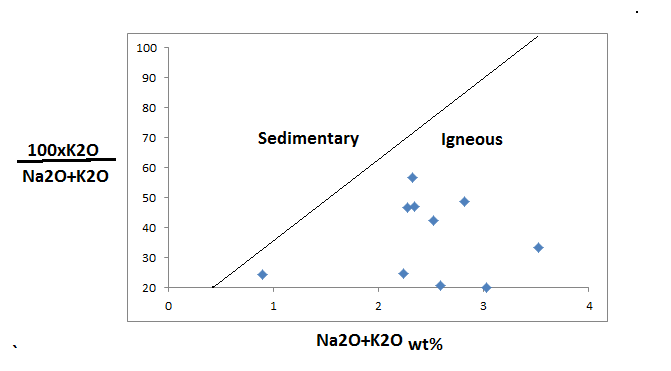 | Figure 3. Plot of Na2O + K2O vs 102 xK2O/ Na2O + K2O of Guguruji Amphibolites, After [30] |
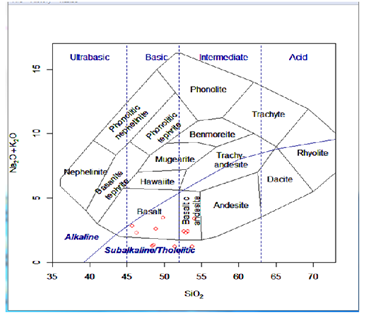 | Figure 4. Plot of Na2O+K2O vs SiO2 discrimination diagram reveals the subalkaline, basaltic nature of the amphibolites, After Cox et al (1979) |
 | Figure 5. Ternary plot: Fe2O3 – Na2O + K2O – MgO of the amphibolites showing tholeiitic affinity, After [32] |
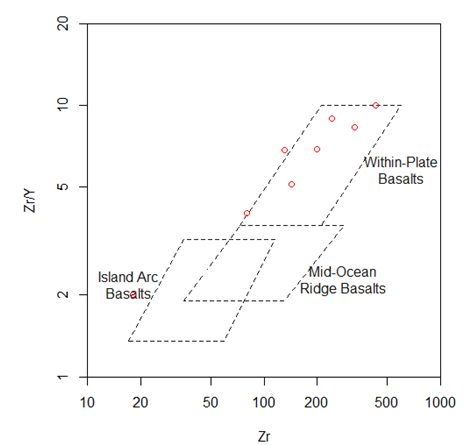 | Figure 6. Plot of Zr/Y vs Zr assigns Guguruji Amphibolites to Within-Plate basalts |
6. Conclusions
- This study reflects that Guguruji amphibolites compares favourably well with other amphibolites referenced in this work in terms of Geochemistry and petrogenesis. Plots of discriminating elements: 100XNa2O/Na2O+K2O versus Na2O+K2O wt %, The Ternary plots and the Zr/Y versus Zr implicate an orthogenetic source for the Guguruji amphibolites.
 Abstract
Abstract Reference
Reference Full-Text PDF
Full-Text PDF Full-text HTML
Full-text HTML